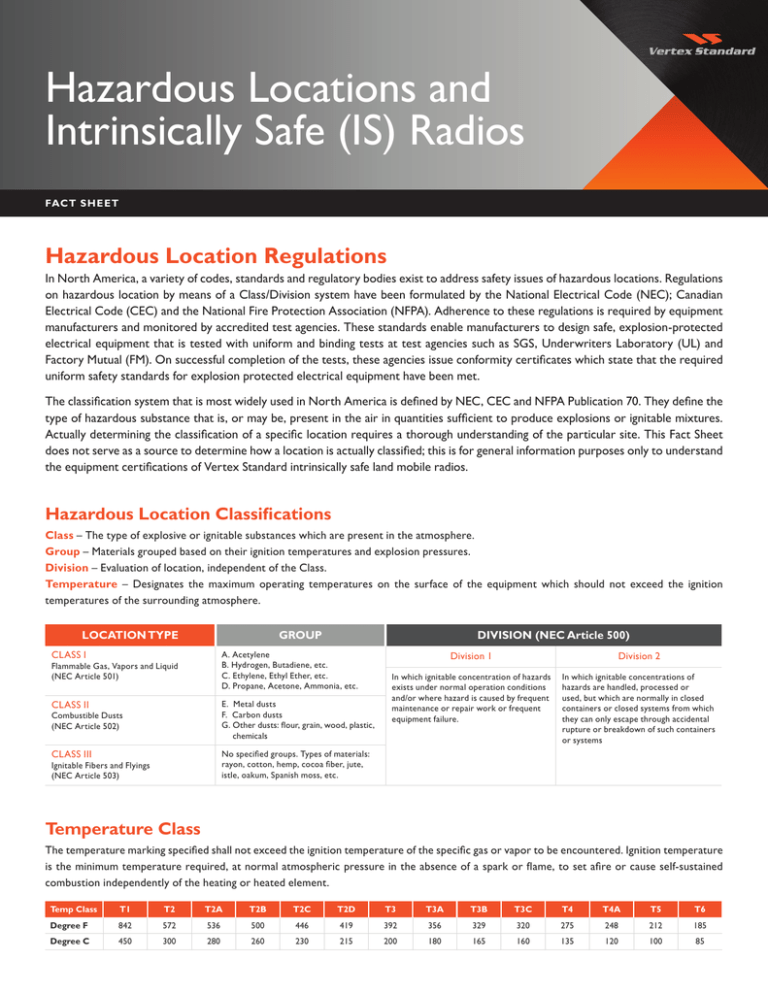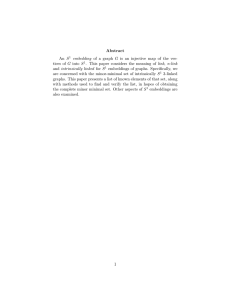
Hazardous Locations and
Intrinsically Safe (IS) Radios
FACT S H E ET
Hazardous Location Regulations
In North America, a variety of codes, standards and regulatory bodies exist to address safety issues of hazardous locations. Regulations
on hazardous location by means of a Class/Division system have been formulated by the National Electrical Code (NEC); Canadian
Electrical Code (CEC) and the National Fire Protection Association (NFPA). Adherence to these regulations is required by equipment
manufacturers and monitored by accredited test agencies. These standards enable manufacturers to design safe, explosion-protected
electrical equipment that is tested with uniform and binding tests at test agencies such as SGS, Underwriters Laboratory (UL) and
Factory Mutual (FM). On successful completion of the tests, these agencies issue conformity certificates which state that the required
uniform safety standards for explosion protected electrical equipment have been met.
The classification system that is most widely used in North America is defined by NEC, CEC and NFPA Publication 70. They define the
type of hazardous substance that is, or may be, present in the air in quantities sufficient to produce explosions or ignitable mixtures.
Actually determining the classification of a specific location requires a thorough understanding of the particular site. This Fact Sheet
does not serve as a source to determine how a location is actually classified; this is for general information purposes only to understand
the equipment certifications of Vertex Standard intrinsically safe land mobile radios.
Hazardous Location Classifications
Class – The type of explosive or ignitable substances which are present in the atmosphere.
Group – Materials grouped based on their ignition temperatures and explosion pressures.
Division – Evaluation of location, independent of the Class.
Temperature – Designates the maximum operating temperatures on the surface of the equipment which should not exceed the ignition
temperatures of the surrounding atmosphere.
LOCATION TYPE
GROUP
CLASS I
DIVISION (NEC Article 500)
A. Acetylene
B. Hydrogen, Butadiene, etc.
C. Ethylene, Ethyl Ether, etc.
D. Propane, Acetone, Ammonia, etc.
Flammable Gas, Vapors and Liquid
(NEC Article 501)
CLASS II
E. Metal dusts
F. Carbon dusts
G. O
ther dusts: flour, grain, wood, plastic,
chemicals
CLASS III
No specified groups. Types of materials:
rayon, cotton, hemp, cocoa fiber, jute,
istle, oakum, Spanish moss, etc.
Combustible Dusts
(NEC Article 502)
Ignitable Fibers and Flyings
(NEC Article 503)
Division 1
Division 2
In which ignitable concentration of hazards
exists under normal operation conditions
and/or where hazard is caused by frequent
maintenance or repair work or frequent
equipment failure.
In which ignitable concentrations of
hazards are handled, processed or
used, but which are normally in closed
containers or closed systems from which
they can only escape through accidental
rupture or breakdown of such containers
or systems
Temperature Class
The temperature marking specified shall not exceed the ignition temperature of the specific gas or vapor to be encountered. Ignition temperature
is the minimum temperature required, at normal atmospheric pressure in the absence of a spark or flame, to set afire or cause self-sustained
combustion independently of the heating or heated element.
Temp Class
T1
T2
T2A
T2B
T2C
T2D
T3
T3A
T3B
T3C
T4
T4A
T5
T6
Degree F
842
572
536
500
446
419
392
356
329
320
275
248
212
185
Degree C
450
300
280
260
230
215
200
180
165
160
135
120
100
85
Hazardous Locations and Intrinsically Safe (IS) Radios
FACT S H E ET
www.vertexstandard.com
Intrinsically Safe Defined
Intrinsic safety is a designed/engineered explosion protection method that is integral to the electrical circuit. Intrinsically safe equipment shall not
be capable of releasing sufficient electrical or thermal energy under normal or abnormal conditions to cause ignition of a specific hazardous
atmospheric mixture. Intrinsically safe certified electrical equipment must be distinctively marked in accordance to the classified area in which it
can be installed. The minimum marking must indicate:
• Class
• Division
• Group
• Maximum safe operating temperature or temperature range
• Any special conditions that have to be observed
Vertex Standard Intrinsically Safe Certified Radios
All Vertex Standard intrinsically safe certified land mobile radios are tested in accordance with the ANSI/UL 913-1997 Fifth
Edition Standard for Safety for Intrinsically Safe Apparatus and Associated Apparatus for use in Class I, II, and III, Division 1
Hazardous Locations. Certifications have been obtained from the SGS-U.S. Testing Center for the following radios:
VX-450 Series
EVX-530 Series
VX-820 Series
VX-920 Series
Intrinsically Safe Certification
Class I, II, III
Division I – Group C, D, E, F, G
Temp Class T3C
• VHF: 134 – 174 MHz
• UHF: 400 – 470 MHz, 450 – 512 MHz
• Analog
• 700 mW Audio Output
• 32 Channels/2 Groups (VX-451)
• 512 Channels/32 Groups (VX-454/459)
• IP 57 Submersible
• Auto-Range Transpond System II (ARTS II)
• Voice Channel Announce
• VHF: 136 – 174 MHz
• UHF: 400 – 470 MHz, 450 – 512 MHz
• Digital and Analog
• 700 mW Audio Output (EVX-534/539)
• 500 mW Audio Output (EVX-531)
• 32 Channels/2 Groups (EVX-531)
• 512 Channels/32 Groups (EVX-534/539)
• IP 57 Submersible
• Auto-Range Transpond System II (ARTS II)
• Voice Channel Announce
• VHF: 134 – 174 MHz
• UHF: 400 – 470 MHz, 450 – 512 MHz
• Analog
• 700 mW Audio Output
• 16 Channels (VX-821)
• 512 Channels/32 Groups (VX-824/829)
• IP 57 Submersible
• Auto-Range Transpond System (ARTS)
• VHF: 134 – 174 MHz
• UHF: 400 – 470 MHz, 450 – 512 MHz
• Analog
• 700 mW Audio Output
• 48 Channels/3 Groups (VX-921)
• 512 Channels/32 Groups (VX-924)
• IP 57 Submersible
• Auto-Range Transpond System (ARTS)
Accessories Used with Intrinsically Safe Radios
Only manufacturer-designated, IS-approved accessories can be used with IS-certified radios. Batteries and accessories do not feature the IS
certification markings. Additional IS-approved batteries and accessories may be used after the initial radio package is purchased. Replacement
batteries and accessories can be sold indefinitely as long as model numbers do not change. Radios in the field will still be approved as long as the
battery/accessory has not changed (model number and suffix remain the same).
Repairing Intrinsically Safe Radios
Only Vertex Standard’s repair center is authorized to repair IS-certified Vertex Standard radios. If a radio is repaired anywhere else, the IS
certification becomes void.
Specifications are subject to change without notice or obligation. The information contained in this publication is intended for general information purposes only. This is not a substitute for review of the
applicable regulations and standards and should not be construed as legal advice or opinion. Readers with specific questions regarding the standards should refer to the cited regulation or consult with an
attorney. Vertex Standard is a trademark of Vertex Standard LMR, Inc. All other trademarks are the property of their respective owners. © 2014 Vertex Standard LMR, Inc. All rights reserved. NAFS_03/2014


